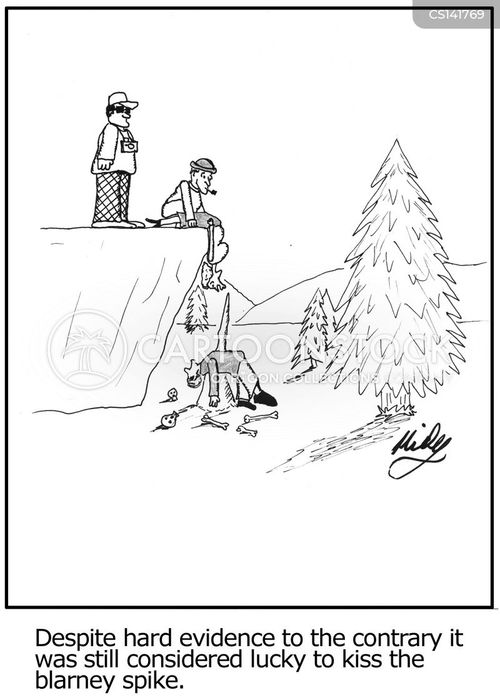Tuesday,
August 9, 2016
Today
the ship docked in Cobh, Ireland. This town has several claims to
fame. They used to be a sending off port for those being deported to
penal colonies such as Australia. This port was also the departure
point for 2.5 million of the 6 million Irish people who emigrated to
North America between 1848 and 1950. More famously, this was the spot where the Titanic picked up its final passengers. 123
passengers boarded here in all; only 44 of those survived the sinking. For those
who are wondering why you don't recognize the name “Cobh,” that's
because it used to be called Queenstown.
The
ship offered a full day tour that we liked, but Frankie found the
same tour with another company for $200 less, yeah.
First
stop, Blarney Castle! The site dates back to before 1200, with a
wooden house. It was replaced by a stone fortification but destroyed
in 1446. In 1446, the third
castle was built by Dermot McCarthy,
King of Munster.
In 1586, Queen Elizabeth I ordered The Earl of Leicester to take
possession of the castle. The McCarthy clan always found ways to
delay negotiations, for example throwing a banquet. Progress reports
to the queen were long letters full of excuses, and the castle remained untaken. In
her irritation, the queen declared the reports to be full of
“blarney”.
The castle has changed hands several times. In 2008, the present estate owner had to go to court to eject a man who had lived on the property for 44 years.
Imagecredit:http://f.tqn.com/y/goireland/1/W/0/P/-/-/elizabeth-i-blarney.png
The castle has changed hands several times. In 2008, the present estate owner had to go to court to eject a man who had lived on the property for 44 years.
Imagecredit:http://media.irishcentral.com/images/swf+blarney+castle.jpg
Imagecredit:https://underaglassmoondotorg.files.wordpress.com/2011/12/kiss-the-blarney-stone-coloring-page.jpg
Kissing
the stone is not easy. First, you have to climb 127 steps to the top of the
castle. Then the lineup. When it's your turn, you have to lay on
your back and lean way out over empty space to kiss the stone. They have
added railings for you to hold onto, and someone is paid to hold each
tourist. Before the railings, they would just grab your boots and
dangle you over. Sherlock Holmes solved a case of murder here,
deeming the boots to have been greased.
To
kiss or not to kiss??? The question kind of answered itself when we got into line and found out it was a one hour wait. Since we only had 2 hours total, we decided we'd rather spend time exploring the rest of the extensive property.
We started with the Poison Garden which contains all poisonous plants (and cannabis).
Then we found a really nice large rock garden area, with natural rock formations called Druid's Circle, Witch's Cave, and the Wishing Steps.
These are three of the Seven Sisters:
The trees all had knitted socks around them:
The bus was 15 minutes leaving Blarney. Then when we were 10 minutes out, the guide told us that 2 people had been left behind and we had to go back to get them. Hello!?!? All kinds of stupidity there, first by people who can't catch a bus that is 15 minutes late, and secondly by a guide that doesn't know how many people he is responsible for.....
After Blarney, we had a driving tour through the city of Cork.
We looked out over the waters where the Lusitania was sunk on its 202nd sailing on May 7, 1915. The mighty passenger ship was running parallel to the south coast of Ireland and was roughly 13 km away from Kinsale, when it crossed paths with a German U-boat, who fired one torpedo. Because of the severe list of the ship, only 6 of the 48 lifeboats were launched successfully. The ship sank in 18 minutes, and 1,198 of the 1,962 passengers and crew lost their lives, most of whom were British or Canadian. Even though only 128 Americans were killed, the sinking of the Lusitania was instrumental in convincing the Americans to join the war.
Imagecredit:https://upload.wikimedia.org/wikipedia/commons/8/81/Bundesarchiv_DVM_10_Bild-23-61-17,_Untergang_der_%22Lusitania%22.jpg
The Germans felt that they had been justified in firing because the Lusitania was listed as an auxiliary war ship and was carrying ammunitions and military cargo. The German Embassy had even issued a warning before the ship sailed on this voyage. The British government has always maintained that there were no munitions on board. However, in 1982 they did warn divers (that were going down to the wreck) of a large amount of “ammunition” on board, some of which was “highly dangerous”.
Imagecredit:http://www.lusitania.net/lastrestingplace_htm_files/Lucy%202008%20-%20bullets.jpg
Chairmans
Lane runs downhill towards the harbour and leads to the center of
town. The lane has pretty cottages all attached to each other, with names such as Giants Cottage
and MansionHouse.
The
final part of our tour was back in Cobh so we could be close to our
ship. The Old Church Cemetery contains mass graves for the remains of 193 of the Lusitania victims.
We had a stop at St Colman's Catholic Cathedral. It was begun in 1868 and took 47 years to complete.
Imagecredit:http://www.irishexaminer.com/remote/media.central.ie/media/images/z/zzzLusitaniaTommyBarkerP4A_large.jpg?width=648&s=ie-328221
Here is the floor in the cathedral. Very Irish:
Even though we were late going to supper back on the ship, we still got our window seat and still made it in time for the evening magician show. He was a semi-fnalist on Spain's Got Talent.











No comments:
Post a Comment